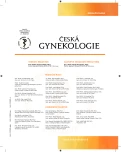Intrahepatic cholestasis of pregnancy
Authors:
Z. Fartáková 1; P. Šimják 1
; L. Vítek 2; K. Adamcová 1; V. Horáková 1; M. Koucký 1; M. Hill 3; M. Dušková 3; A. Pařízek 1
Authors‘ workplace:
Gynekologicko-porodnická klinika VFN a 1. LF UK, Praha, přednosta prof. MUDr. A. Martan, DrSc.
1; Ústav lékařské biochemie a laboratorní diagnostiky 1. LF UK, Praha, přednosta prof. MUDr. T. Zima, DrSc., MBA
2; Endokrinologický ústav, Praha, ředitelka ústavu doc. MUDr. B. Bendlová, CSc.
3
Published in:
Ceska Gynekol 2013; 78(3): 276-280
Overview
The review of intrahepatic cholestasis of pregnancy attempts to summarize the current knowledge of this disease by analysing available literary sources.
Intrahepatic cholestasis of pregnancy is a disease that typically appears in the third trimester of pregnancy, sometimes already at the end of the second trimester of pregnancy. The main symptom of the disease is pruritus. In addition, the disease is characterized by increased levels of liver enzymes and bile acids. The symptoms of the disease disappear spontaneously after delivery. The disease is associated with high incidence of fetal distress, as well as with a high risk of premature labour. The most serious obstetric complication is antenatal sudden fetal death. Fetal complications are probably caused by elevated levels of bile acids. Therefore the aim of treatment should be to minimize negative effects of bile acids on the fetus, to prolong pregnancy and reduce maternal symptoms at the same time.
Keywords:
intrahepatic cholestasis – pregnancy – pruritus – bile acids – pregnancy-related liver disease
Sources
1. Beuers, U., Boberg, KM., Chapman, RW., et al. European Association for the Study of the Liver. EASL Clinical Practice Guidelines: management of cholestasic liver diseases. J Hepatol, 2009, 51(2), p. 237–267. Doi: 10.1016/j.hep.2009.04.009. Epub 2009 Jun 6.
2. Binder, T. Doporučené postupy v perinatologii, Těhotenská cholestatická hepatóza – doporučený postup. Praha: Česká lékařská společnost Jana Evangelisty Purkyněho. Čes Gynek, 2011, s. 26–27.
3. Binder, T., Salaj, P., Zima, T., Vítek, L. Randomized prospective comparative study of ursodeoxycholic acid and S-adenosyl-L-methionine in treatment of intrahepatic cholestasis of pregnancy. J Perinat Med, 2006, 2006, 34(5), p. 383–391.
4. Binder, T., Zima, T., Vítek, L. Biochemické aspekty těhotenské cholestatické hepatózy. Čes Gynek, 2007, 72, 2 s. 90–94.
5. Floreani, A., Caroli, D., Memmo, A., et al. Gene expression profile in intrahepatic cholestasis of pregnancy [abstract 1546]. Presented at the Annual Meeting of American Association for Study of Liver Disease, Boston MA, November 1–4, 2009.
6. Floreani, A., Carderi, I., Paternoster, D., et al. Hepatobiliary phospholipid transporter ABCB4, MDR3 gene variants in a large cohort of Italian women with intrahepatic cholestasis of pregnancy. Dig Liver Dis, 2008, 40, p. 366–370.
7. Geenes, V., Williamson, C. Intrahepatic cholestasis of pregnancy. World J Gastroenterol, 2009, 15, p. 2049–2066.
8. Germain, AM., Kato, S., Carvajal, JA., et. al. Bile acid increase response and expression of human myometrial oxytocin receptor. Am J Obstet Gynecol, 2003, 189, p. 577–582.
9. Glantz, A., Reilly, SJ., Benthin, L., et. al. Intrahepatic cholestasis of pregnancy: amelioration of pruritus by UDCA is associated with decreased progesterone disulphates in urine. Hepatology, 2008, 47, p. 544–551.
10. Glantz, A., Marschall, HU., Lammert, F., et. al. Intrahepatic cholestasis of pregnancy: a randomized controlled trial comparing dexamethasone and ursodeoxycholic acid. Hepatology, 2005, 42, p. 1399–13405.
11. Glantz, A., Marschall, HU., Mattsson, LA. Intrahepatic cholestasis of pregnancy: relationship between bile acid levels and fetal complication rates. Hepatology, 2004, 40, p. 467–474.
12. Guyton, AC., Hall, JE. Textbook of medical physiology, eleventh ed. Philadelphia: Elsevier Saunders, 2006.
13. Lammert, F., Marschall, HU., Glantz, A., et. al. Intrahepatic cholestasis of pregnancy: molecular pathogenesis, diagnosis and management. J Hepatol, 2000, 33, p. 1012–1021.
14. Meier, PJ., Stieger, B. Bile salt transporters. Ann Rev Physiol, 2002, 64, p. 635–661.
15. Reichen, J., Paumgartner, G. Uptake of bile acids by perfused rat liver. Am J Physiol, 1976, 231, p. 734–742.
16. Reyes, H., Sjovall, J. Bile acids and progesterone metabolites in intrahepatic cholestasis of pregnancy. Ann Med, 2000, 32, p. 94–106.
17. Reyes, H., Zapata, R., Hernandez, I., et al. Is a leaky gut involved in pathogenesis of intrahepatic cholestasis of pregnancy? Hepatology, 2006, 43, p. 715–722.
18. Reyes, H. Sex hormones and bile acids in intrahepatic cholestasis of pregnancy. Hepatology, 2008, 47, p. 376–379.
19. Reyes, H., Baez, ME., Gonzalez, MC., et al. Selenium, zinc and copper plasma levels in intrahepatic cholestasis of pregnancy, in normal pregnancies and in healthy individuals, in Chile. J Hepatol, 2000, 32, p. 542–549.
20. Roda, A., Cappelleri, G., Aldini, R., et al. Quantitative aspects of the interaction of bile acids with human serum albuminJ Lipid Res, 1982, 23, p. 490–495.
21. Savonius, H., Riikonen, S., Gylling, H., et al. Pregnancy outcome with intrahepatic cholestasis. Acta Obstet Gynecol Scand, 2000, 79, p. 323–325.
22. Salvioli, G., Lugli, R., Pradelli, JM., Gigliotti, G. Bile acid binding in plasma: the importance of lipoproteins. FEBS lett, 1985, 187, p. 272–276.
23. Stieger, B., Fattinger, K., Madon, J., et al. Drug- and estrogen-induced cholestasis through inhibition of the hepatocellular bile salt export bump (Bsep) of rat liver. Gastroenterology, 2000, 118, p. 422–430.
24. Trauner, M., Arrese, M., Soroka, CJ., et al. The rat canalicular conjugate export pump (Mrp2) is down-regulated in intrahepatic and obstructive cholestasis. Gastroenterology, 1997, 113, p. 255–264.
25. Williamson, C., Miragoli, M., Sheikh Abdul Kadir, S., et al. Bile acid signaling in fetal tissues: implications for intrahepatic cholestasis of pregnancy. Dig Dis, 2011, 29(1), p. 58–61. Epub 2011 Jun 17.
26. Williamson, C., Gorelik J., et al. The bile acid taurocholate impairs rat cardiomyocyte function: a proposed mechanism for intra-uterine fetal death in obstetric cholestasis. Clin Sci, 2001, 100, p. 363–369.
Labels
Paediatric gynaecology Gynaecology and obstetrics Reproduction medicineArticle was published in
Czech Gynaecology

2013 Issue 3
Most read in this issue
- Intrahepatic cholestasis of pregnancy
- Determination of anti-Müllerian hormone in women
- Antibiotic profylaxis in obstetrics
- Peripartum cardiomyopathy after caesarean section – a case report
